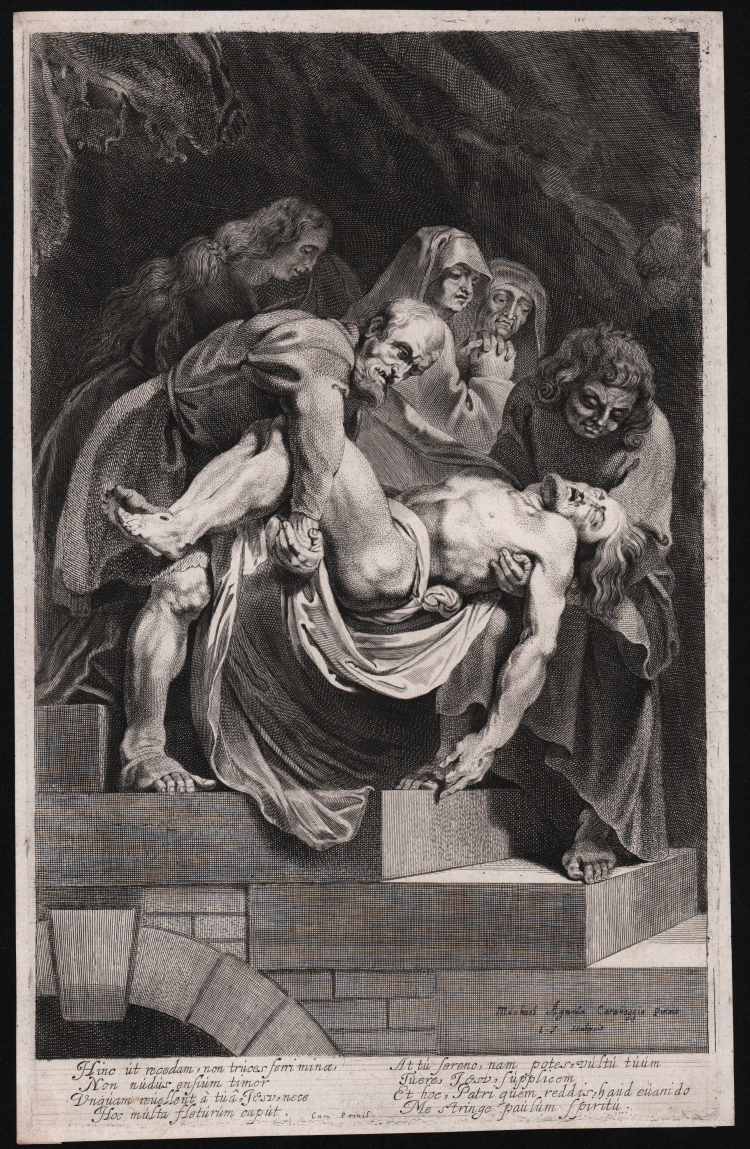



| Reference: | S45133 |
| Author | Jonas SUYDERHOEF |
| Year: | 1650 ca. |
| Measures: | 200 x 320 mm |


| Reference: | S45133 |
| Author | Jonas SUYDERHOEF |
| Year: | 1650 ca. |
| Measures: | 200 x 320 mm |
The Entombment. View of a cave with St John and Nicodemus lifting Christ's body, the three Maries beyond; after Michelangelo Merisi da Caravaggio
Engraving, lettered within image, in lower right: "Michael Angelo Carauaggio Pinxit / I.S. Sculpsit". Lettered in Latin in lower margin, two columns with four lines each: "Hinc ut recedam, ... / ... paulum spiritu." and "Cum Priuil".
Caravaggio's Deposition was made between 1602 and 1604 and is one of the artist's few works that did not receive criticism. The painting made its public appearance in 1604 at the chapel of the church of Santa Maria in Vallicella. It had been commissioned by the nephew of Piero Vittrice, who died between late 1601 and 1602 and who in life had been butler and cloakroom attendant to Pope Gregory XIII. In Caravaggio's Deposition, Christ's body is supported by St. John and Nicodemus. Mary, Magdalene, and a woman with raised arms stand behind them arranged in a pyramid pattern. It looks almost like a sculptural group, and the movement of the scene seems slowed down, almost theatrical.
Magnificent proof, rich in tone, impressed on contemporary laid virgin paper, with margins, in perfect condition.
Bibliografia
Hollstein / Dutch and Flemish etchings, engravings and woodcuts c.1450-1700 (1.I).
Jonas SUYDERHOEF (Haarlem 1613 – 1686)
|
Dutch etcher and engraver. He was the son of Andreas Pietersz. Suyderhoef, secretary to the first Dutch ambassador in Constantinople. A reproductive engraver with an oeuvre of some 138 prints, Jonas worked after the compositions of 50 or more different artists, including Anthony van Dyck, Frans Hals, Gerrit van Honthorst, Adriaen van Ostade, Rubens, Joachim von Sandrart and Gerard ter Borch the younger, as well as Caravaggio, Jan Lievens and Rembrandt.
Suyderhoef, in his prints after Hals, managed to imitate the effect of painted half-tones through his delicate handling of the etching needle. The subtle alternation of highlighted and shaded parts in these prints also contributes to the masterly rendering of Hals's broad touch. Suyderhoef tended to finish his plates off with the burin. As well as some 107 portraits, there is a group after genre compositions by Adriaen van Ostade, including several large prints.
Suyderhoef's latest dated print is a portrait of Noah Smaltius (1668; Hollstein, no. 118), after Johan Thopas (c. 1630-c. 1700). After 1664 Suyderhoef's name occurs repeatedly in the books of Haarlem's guild, of which he served as dean in 1678.
|
Jonas SUYDERHOEF (Haarlem 1613 – 1686)
|
Dutch etcher and engraver. He was the son of Andreas Pietersz. Suyderhoef, secretary to the first Dutch ambassador in Constantinople. A reproductive engraver with an oeuvre of some 138 prints, Jonas worked after the compositions of 50 or more different artists, including Anthony van Dyck, Frans Hals, Gerrit van Honthorst, Adriaen van Ostade, Rubens, Joachim von Sandrart and Gerard ter Borch the younger, as well as Caravaggio, Jan Lievens and Rembrandt.
Suyderhoef, in his prints after Hals, managed to imitate the effect of painted half-tones through his delicate handling of the etching needle. The subtle alternation of highlighted and shaded parts in these prints also contributes to the masterly rendering of Hals's broad touch. Suyderhoef tended to finish his plates off with the burin. As well as some 107 portraits, there is a group after genre compositions by Adriaen van Ostade, including several large prints.
Suyderhoef's latest dated print is a portrait of Noah Smaltius (1668; Hollstein, no. 118), after Johan Thopas (c. 1630-c. 1700). After 1664 Suyderhoef's name occurs repeatedly in the books of Haarlem's guild, of which he served as dean in 1678.
|